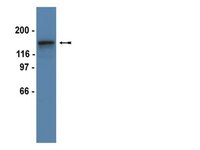04-825 Sigma-AldrichAnti-PDGFRβ Antibody, clone 4A56, rabbit monoclonal
This Anti-PDGFRβ Antibody, clone 4A56 is validated for use in IP, WB for the detection of PDGFRβ.
More>> This Anti-PDGFRβ Antibody, clone 4A56 is validated for use in IP, WB for the detection of PDGFRβ. Less<<Recommended Products
Overview
| Replacement Information |
|---|
Key Spec Table
| Species Reactivity | Key Applications | Host | Format | Antibody Type |
|---|---|---|---|---|
| M, H | IP, WB | Rb | Culture Supernatant | Monoclonal Antibody |
| Description | |
|---|---|
| Catalogue Number | 04-825 |
| Replaces | 05-825 |
| Brand Family | Upstate |
| Trade Name |
|
| Description | Anti-PDGFRβ Antibody, clone 4A56, rabbit monoclonal |
| References |
|---|
| Product Information | |
|---|---|
| Format | Culture Supernatant |
| Control |
|
| Presentation | Cultured supernantant in 0.05% sodium azide |
| Quality Level | MQ100 |
| Physicochemical Information |
|---|
| Dimensions |
|---|
| Materials Information |
|---|
| Toxicological Information |
|---|
| Safety Information according to GHS |
|---|
| Safety Information |
|---|
| Storage and Shipping Information | |
|---|---|
| Storage Conditions | Stable for 1 year at -20°C from date of receipt. For maximum recovery of product, centrifuge the vial prior to removing the cap. |
| Packaging Information | |
|---|---|
| Material Size | 100 µL |
| Transport Information |
|---|
| Supplemental Information |
|---|
| Specifications |
|---|
| Global Trade Item Number | |
|---|---|
| Catalogue Number | GTIN |
| 04-825 | 04053252469763 |
Documentation
Anti-PDGFRβ Antibody, clone 4A56, rabbit monoclonal MSDS
| Title |
|---|
Anti-PDGFRβ Antibody, clone 4A56, rabbit monoclonal Certificates of Analysis
| Title | Lot Number |
|---|---|
| Anti-PDGFR, clone 4A56 - 2341100 | 2341100 |
| Anti-PDGFR, clone 4A56 - DAM1561706 | DAM1561706 |
| Anti-PDGFRβ, clone 4A56 - 2392255 | 2392255 |
| Anti-PDGFRβ, clone 4A56 - 3521055 | 3521055 |
| Anti-PDGFRβ, clone 4A56 Monoclonal Antibody | 3140996 |
| Anti-PDGFRβ, clone 4A56 Monoclonal Antibody | 3086142 |
| Anti-PDGFRβ, clone 4A56 Monoclonal Antibody | 2956754 |
| Anti-PDGFRβ, clone 4A56 Monoclonal Antibody | 2867094 |







